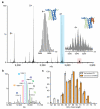High-resolution mass spectrometry of small molecules bound to membrane proteins
- PMID: 26901650
- PMCID: PMC4856209
- DOI: 10.1038/nmeth.3771
High-resolution mass spectrometry of small molecules bound to membrane proteins
Abstract
Small molecules are known to stabilize membrane proteins and to modulate their function and oligomeric state, but such interactions are often hard to precisely define. Here we develop and apply a high-resolution, Orbitrap mass spectrometry-based method for analyzing intact membrane protein-ligand complexes. Using this platform, we resolve the complexity of multiple binding events, quantify small molecule binding and reveal selectivity for endogenous lipids that differ only in acyl chain length.
Figures



Similar articles
-
The role of interfacial lipids in stabilizing membrane protein oligomers.Nature. 2017 Jan 19;541(7637):421-424. doi: 10.1038/nature20820. Epub 2017 Jan 11. Nature. 2017. PMID: 28077870 Free PMC article.
-
Direct determination of oligomeric organization of integral membrane proteins and lipids from intact customizable bilayer.Nat Methods. 2023 Jun;20(6):891-897. doi: 10.1038/s41592-023-01864-5. Epub 2023 Apr 27. Nat Methods. 2023. PMID: 37106230 Free PMC article.
-
Probing Heterogeneous Lipid Interactions with Membrane Proteins Using Mass Spectrometry.Methods Mol Biol. 2019;2003:175-190. doi: 10.1007/978-1-4939-9512-7_9. Methods Mol Biol. 2019. PMID: 31218619
-
Different modes of lipid binding to membrane proteins probed by mass spectrometry.J Am Chem Soc. 2015 Apr 29;137(16):5240-7. doi: 10.1021/jacs.5b00420. Epub 2015 Apr 16. J Am Chem Soc. 2015. PMID: 25860341 Review.
-
Mass spectrometry--from peripheral proteins to membrane motors.J Mol Biol. 2012 Oct 12;423(1):1-13. doi: 10.1016/j.jmb.2012.06.033. Epub 2012 Jun 28. J Mol Biol. 2012. PMID: 22750574 Free PMC article. Review.
Cited by
-
The GFP thermal shift assay for screening ligand and lipid interactions to solute carrier transporters.Nat Protoc. 2021 Dec;16(12):5357-5376. doi: 10.1038/s41596-021-00619-w. Epub 2021 Oct 27. Nat Protoc. 2021. PMID: 34707255 Review.
-
Double and triple thermodynamic mutant cycles reveal the basis for specific MsbA-lipid interactions.bioRxiv [Preprint]. 2023 Nov 6:2023.07.03.547565. doi: 10.1101/2023.07.03.547565. bioRxiv. 2023. Update in: Elife. 2024 Jan 22;12:RP91094. doi: 10.7554/eLife.91094. PMID: 37461710 Free PMC article. Updated. Preprint.
-
Parsimonious Charge Deconvolution for Native Mass Spectrometry.J Proteome Res. 2018 Mar 2;17(3):1216-1226. doi: 10.1021/acs.jproteome.7b00839. Epub 2018 Feb 8. J Proteome Res. 2018. PMID: 29376659 Free PMC article.
-
Native top-down mass spectrometry provides insights into the copper centers of membrane-bound methane monooxygenase.Nat Commun. 2019 Jun 17;10(1):2675. doi: 10.1038/s41467-019-10590-6. Nat Commun. 2019. PMID: 31209220 Free PMC article.
-
Development and Evaluation of a Reverse-Entry Ion Source Orbitrap Mass Spectrometer.J Am Soc Mass Spectrom. 2019 Jan;30(1):192-198. doi: 10.1007/s13361-018-1976-0. Epub 2018 May 23. J Am Soc Mass Spectrom. 2019. PMID: 29796735 Free PMC article.
References
Methods Only References
-
- Hsu F-F, et al. Structural characterization of cardiolipin by tandem quadrupole and multiple-stage quadrupole ion-trap MS with electrospray ionization. Journal of the American Society for MS. 2005;16:491–504. - PubMed
Publication types
MeSH terms
Substances
Grants and funding
LinkOut - more resources
Full Text Sources
Other Literature Sources

